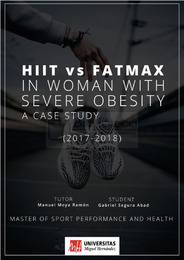Por favor, use este identificador para citar o enlazar este ítem:
https://hdl.handle.net/11000/6064Registro completo de metadatos
| Campo DC | Valor | Lengua/Idioma |
|---|---|---|
| dc.contributor.advisor | Moya Ramón, Manuel | - |
| dc.contributor.author | Segura Abad, Gabriel | - |
| dc.contributor.other | Departamentos de la UMH::Psicología de la Salud | es |
| dc.date.accessioned | 2020-07-07T08:35:58Z | - |
| dc.date.available | 2020-07-07T08:35:58Z | - |
| dc.date.created | 2018-06 | - |
| dc.date.issued | 2020-07-07 | - |
| dc.identifier.uri | http://hdl.handle.net/11000/6064 | - |
| dc.description.abstract | Obesity is a global epidemic that contributes to develop several health complications as cardiovascular disease, hypertension, type II diabetes, etc. In this line, bariatric surgery appears appears as a possible solution, but it implies a great surgical risk to patients. However, non-invasive methods as physical activity or diet, have shown to reduce the body composition and a healthy and health status without. Aerobic exercise is beneficial in severe obesity, but the discussion about what kind of methodology is better to increase maximal fat oxidation (MFO)during exercise has lasted for a long time. The aim of this study was to compare the effects of high intensity interval training (HIIT) versus training at individual maximal fat oxidation intensity (Fatmax) on body composition, cardiometabolic risk factors and cardiorespiratory fitness in women with severe obesity. | es |
| dc.format | application/pdf | es |
| dc.format.extent | 10 | es |
| dc.language.iso | eng | es |
| dc.rights | info:eu-repo/semantics/openAccess | es |
| dc.subject | HIIT | es |
| dc.subject | Fatmax | es |
| dc.subject | Overweight | es |
| dc.subject | Obesity | es |
| dc.subject | Isocaloric | es |
| dc.subject.other | CDU:79 - Deportes | es |
| dc.title | Effects of HIIT vs Fatmax in woman with severe obesity | es |
| dc.type | info:eu-repo/semantics/masterThesis | es |

Ver/Abrir:
Segura Abad, Gabriel.pdf
1,48 MB
Adobe PDF
Compartir:
 La licencia se describe como: Atribución-NonComercial-NoDerivada 4.0 Internacional.
La licencia se describe como: Atribución-NonComercial-NoDerivada 4.0 Internacional.
.png)